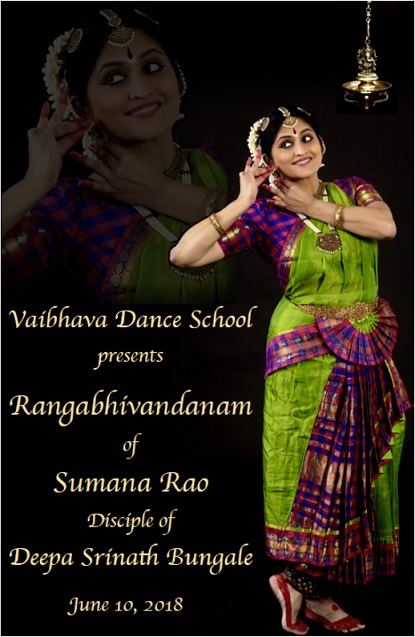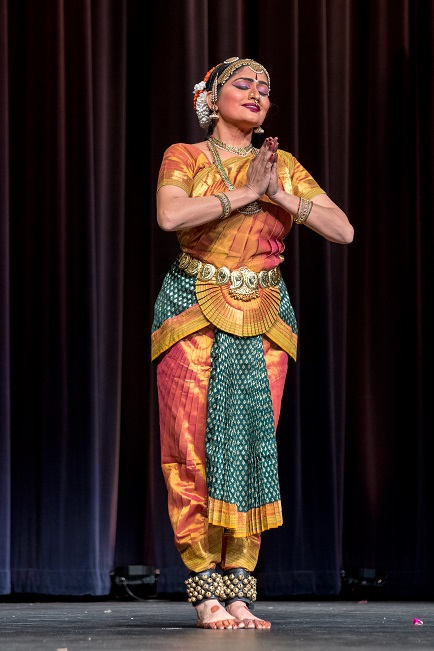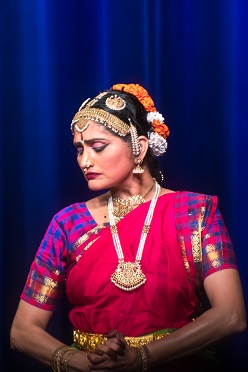Archives
Contribute
|
|
Sumana Rao Presents Rangabhivandanam
|
|
Anuradha Annaswamy
07/11/2018
On June 10, 2018, on a beautiful New England day, Sumana Rao brought the exquisite 2000 year-old art form of Bharatanatyam to life through her Rangabhivandanam, in Scottish Rite Masonic Museum in Lexington, MA.
Before every dance program, there are those mildly anxious moments that inhabits every member of the audience – just as the auditorium goes dark, the curtain raises, and the chatter dies down to a whisper and then quiet – how will the dancer look – tall? Short? Slim? Beautiful eyes? Is she nervous? How will the makeup be? What kind of dress? Sari type? Chudidhar type? Color combination? Contrast? What kind of jewelry? Because we are all ready to like her, ready to embark on this journey with the dancer, the beauty, the rasa, the moods, the music, and savor all images that she evokes and invokes. This evening was no exception. But there were two additional aspects – Sumana is the mother of a 25-year old and a college graduate, and not the standard teenager delivering a debut performance. Second, every one of the 366 members of audience, without a single exception, loved her. Unconditionally. Adored her.
So here was the audience, ready to love Sumana’s performance, no matter how she looked or dressed or danced. But we did not need to be concerned at all - within a few seconds, as the stage lights turned on, after Sneha introduced the first piece, Sumana put us all at tremendous ease. For, what we saw in front of us was not our dear friend who has been around the block a few times, but a superb dancer, confident, comfortable, with a dazzling smile, and ready to entertain us. And that is exactly what she proceeded to do. Over next 120 minutes, with nine items arranged in Margam style, she filled our eyes, our ears, our hearts, our souls, and our entire beings, and simply wowed us!
The program began with a Pushpanjali in Ragam Chakravakam. With clean poses, arm movements, crisp adavus, and perfect rhythm, Sumana offered the pushpanjali, her salutation to the lord of dance Nataraja, the Guru, the musicians and the audience. The item then segued into the second piece, Gajananayutham, an item in praise of Lord Ganesha, in Ragam Vegavaahini. Sumana brought the lord of Devas to life, the elephant-faced God worshipped by Bhootaganas. With Ganesha’s blessings, and all obstacles completely removed, we were well on our way into the program, ready to immerse in what follows and thoroughly enjoy ourselves!
The next item was a pure nritta piece, Mysore Jathi. Akin to jathiswaram, it’s an abstract dance, and combines rhythmic sequences of movements in groupings of jathis. It is performed to swara passages in a particular raga (melodic scale) and tala, accompanied by musical instruments. With a slight infusion of the prayer, Mooshika vahana, the piece erased any doubt in the audience’s minds of Sumana’s athleticism, agility, and overall mastery of the pure dance art-form. Age, shmage. The fifty year-old Sumana reminded every woman in that audience, young and old, of what a woman can do if she put her mind to. Go girl!
And she was just getting warmed up. For, the next two pieces were transcendental!
Sadaa Madim, a Krithi on Lord Shiva, composed by Saint Thyagaraja in Raagam Gambheeravani, is a devotee’s plea to Shiva for protection. Shiva is the embodiment of a number of things – bliss, compassion, happiness, power, grace, energy - the list is endless. And we witnessed everyone of these through Sumana’s exposition of this beautiful piece. My personal favorite is the taming of Ganga, who tumultuously flows down to earth following Bhagiratha’s penance to bring her from the heavens to gain Moksha for all of his ancestors who were cursed by a sage to wander the Paataala. Shiva tames Ganga’s turbulence by trapping her in his matted locks and letting her flow in small streams. We saw the entire story unfold in front of us – we saw Bhagiratha praying to Brahma, Ganga’s turbulent descent, and then comes Shiva, we could see and almost feel the matted locks, expertly trapping Ganga, and gently releasing her. En masse, I think the entire audience had goose bumps!
The center piece of any solo dance performance is a Varnam. As summarized eloquently in the dance brochure, “the varam reveals in full, the abstract and expressive aspects of the dance, and builds on the rhythmic, melodic, as well as lyrical aspects of the music. The dancer interprets the music and poetry with great elaboration in both nritta and nritya passages.†And elaborate, she did, and how!
The varnam is a composition by Vidwan Mahesh Swamy, in ragam Ramapriya, a visualization of how Sita, imprisoned in Ashokavana, imagines the life of Rama and misses her husband terribly.
And Sumana took us through this vivid journey that Sita takes. And it’s one of the best journeys that I have ever taken in a varnam. Every iconic scene of the Ramayana was created right in front of us, with the core emotion brilliantly portrayed by our dear friend Sumana. The grandeur of the Raghuvamsha, the protection of Vishwamitra’s Yagna, resurrection of Ahalya from a curse, the incredibly romantic scene when Rama and Sita meet for the first time, the grand spectacle of Sita’s swayamvara and the thrilling conclusion when Rama strings the Shivadanus to only have it break spectacularly, the mutilation of Shurpanaka by Lakshmana, the devious golden deer tricking Rama to leave Sita, the treacherous Ravana abducting Sita, the tragic death of Jatayu valiantly trying to stop Ravana, and looping back often to Sita cruelly imprisoned in the Ashokavana, beseeching Ravana to release her – Sumana transported us into this Ramayana, and enthralled us with the vision of Rama as the son, the pupil, the hero, the warrior, the prince, the husband, and as the embodiment of all things noble, good, loyal, beautiful, and just!
The biggest testimony to Sumana’s abhinaya skills occurred in this piece through Shabari. We saw the old, frail, and hunchbacked lady in front of us, overwhelmed with joy that she will finally see her long-awaited beloved Rama, making sure that she assembles the sweetest of the sweet fruits for her Lord by actually taking small sample-bites, and experiences this boundless happiness when she finally gets the darshan. Fantastic. Superb. Mesmerizing. Bravo!
After a brief intermission, Sumana continued to take us on a Navarasa of emotions in the second half. The first piece was a Ragamalika on Devi and her multitudinous forms, as a Universal Mother, as a daughter, as Shiva’s consort Parvathi, as the Creative power of Shiva, as the Ferocious Kali, and the graceful and benevolent Lakshmi. As Sumana effortlessly evoked every one of these diverse, dramatic, and compelling forms of the feminine, she empowered every one of the audience, especially the female members, with vim and vigor and a resolve to take on the world!
On to the NC-17 portion of the evening, Netrandhi Nerathile, a padam in Ragam Husseini. This item is about a nayaki who is in love with Muruga, and takes Him to task for flirting with another woman by the river as the sun was setting. She’s especially enraged because she was right there and not long before, He was romancing her, showering her with love and kisses. She beseeches Him to return to her, as she has been constantly thinking of Him, forgoing food and worried to no end. We were so rooting for this Nayaki, as Sumana weaved the story in front of us, enraged as to how dare He do this to her, thrilled when she reminded Him of his love and kisses, and happy for her as she got her Muruga back!
From sringara, Sumana took us in the next piece to the ultimate love, between mother and child – Yashoda and Krishna. This unconditional love, whether he was a butter-thief or not, whether he ate mud or not, and ultimately whether he was the Lord of the universe are not, was effortlessly portrayed by our dear friend! And here was yet another wonderful moment of the evening. For many in the audience, the story of Krishna (and all other Hindu gods, for that matter) is not new. We have heard the story thousands of times. We have told the story hundreds of times. We have heard the songs hundreds of times. We have even seen the story unfold as a dance and as a drama countless times. So as Krishna goes on his jaunt to the river to play with his friends, with him looking for whatever mischief he can get into, as he sees the mud, we know exactly what’s going to happen. We smile and shake our heads when he savors and relishes that taste, goes for another handful, we inwardly rub our hands together as Yashoda gets wind of this and takes Krishna to task, and we wait, wait for that moment, that glorious moment when Krishna opens his mouth and shows heaven and earth and lightning and thunder and the entire universe to His divine mother Yashoda. And this extraordinary thing happens where this glorious electric bliss starts from our hearts, traverses our face and mind, arms and legs, travels all over our body, mind, and soul and fills our entire being! Thank you Sumana for providing us with this fantastic moment through your exquisite portrayal of this divine love.
Sumana ended the evening with a Thillana in Ragam Kadanakuthuhalam, a joyful rhythmic rendition, and embodies alluring poses and exquisite patterns of movement. Sumana did full justice to this celebratory conclusion of a beautiful performance.
Fantastic support was provided by the orchestra, starting from Guru Deepa Srinath’s nattuvangam, Vidwan Srinidhi Mattur’s vocal, Vidwan Jitendra Kishore’s violin, Vidwan Narasimhamoorthy Ramamishra’s flute, Vidwan Srihari Rangaswamy’s Mrdangam, and our own youngsters Tarun Bangalore on the Kanjira and Sudarshan Thirumalai on the Rhythm pad. Makeup by Kala Gangadharan was exquisite.
Three things were absolutely clear by the end of the evening. To all women in the audience: “Fifty is the new twenty!†To all men in the audience: “The women have arrived. They are going to take on the world.†To Guru Deepa Srinath Bungale: “You have now become a household name in Greater Boston. Get ready, for every parent with a child interested in dance is going to reach out to you.â€
And Sumana, thank you so much for this incredibly memorable performance! We all love you even more. And I am so proud to have you as my friend. A huge congratulations to you, to Anand, to Aashik, and to Sneha.
Hari Om!
 |
|
You may also access this article through our web-site http://www.lokvani.com/
|
|


